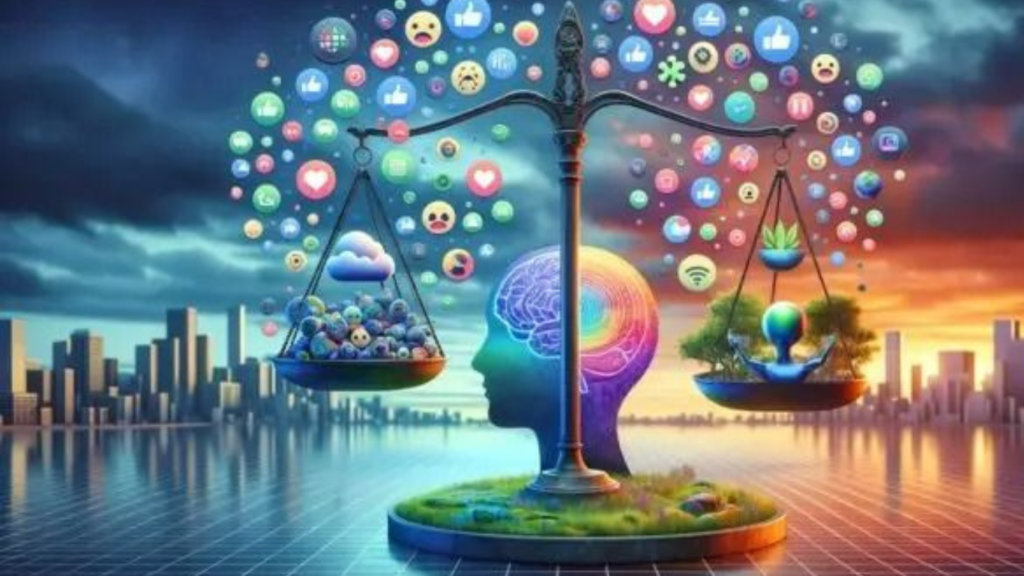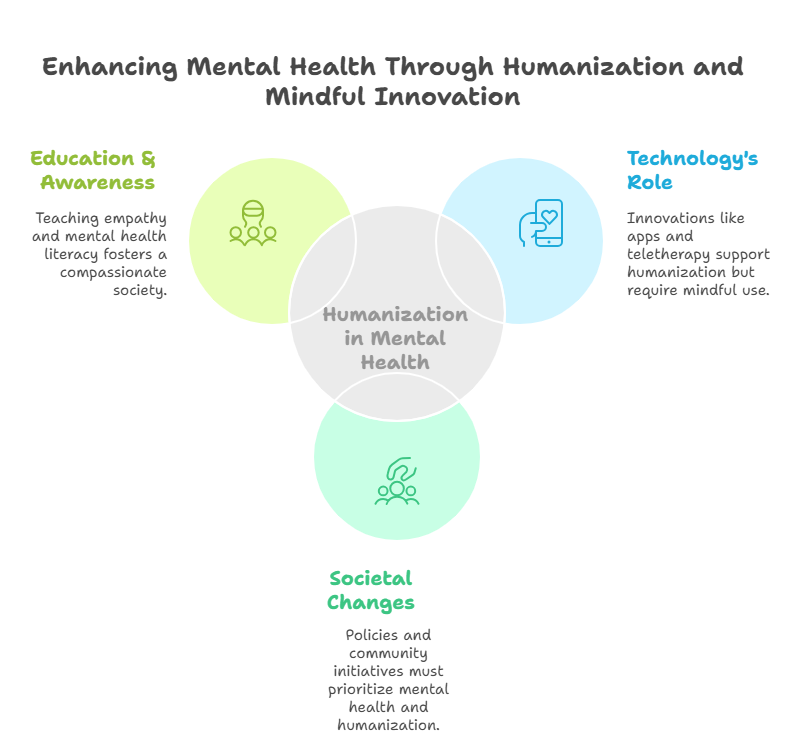In an era defined by rapid technological advancements and relentless productivity, mental health has emerged as one of the most pressing global challenges. According to the World Health Organization (WHO), nearly 1 billion people worldwide suffer from mental health disorders, with anxiety and depression being the most prevalent. Amidst this crisis, the concept of humanization—reconnecting with the core qualities that make us human—has gained significant attention as a potential solution. But what does humanization truly mean, and how can it address the mental health challenges of our time?
Humanization is the process of reclaiming emotional connection, empathy, authenticity, and community—elements that are often eroded in modern society. In a world dominated by screens, algorithms, and superficial interactions, these fundamental aspects of our humanity are frequently neglected. The consequences are stark: rising levels of loneliness, burnout, and a pervasive sense of disconnection.
This blog delves deep into the intersection of mental health and humanization, exploring how reconnecting with our humanity can serve as a transformative tool for well-being. We’ll examine the forces that dehumanize us, the profound impact of humanization on mental health, and actionable strategies to bring more authenticity and connection into our lives. By the end, you’ll not only understand the importance of humanization but also feel empowered to take meaningful steps toward a healthier, more fulfilling life.
Let’s embark on this journey to rediscover what it means to be human—and how this rediscovery can heal our minds, our relationships, and our world.
Section 1: What is Humanization?
Humanization is the process of reconnecting with the qualities that make us fundamentally human. It’s about prioritizing emotional connection, fostering empathy and compassion, embracing authenticity and vulnerability, and cultivating a sense of community and belonging. These elements are the bedrock of our mental and emotional well-being, yet they are often overshadowed in today’s fast-paced, technology-driven world.
Historically, humanization has been a cornerstone of thriving societies. Traditional communities valued face-to-face interactions, shared experiences, and collective support. For example, indigenous cultures often emphasize communal living, storytelling, and rituals that foster a deep sense of belonging and emotional expression. However, as modernization and technological advancements have accelerated, these human-centric practices have taken a backseat.
In the modern context, humanization is about recognizing and honoring our shared humanity. It’s about seeing ourselves and others not as cogs in a machine but as unique, emotional, and interdependent beings. By reclaiming these values, we can create a foundation for better mental health and a more fulfilling life.
Section 2: The Impact of Dehumanization on Mental Health
Dehumanization is the process by which individuals or systems strip away the qualities that make us human. In modern society, this often manifests through over-reliance on technology, workplace demands, and societal pressures.
- Technology and Social Media:
While technology has brought convenience, it has also eroded our ability to connect deeply. Social media, for instance, often promotes comparison and superficial interactions. A study published in the Journal of Social and Clinical Psychology found that excessive social media use is linked to increased feelings of loneliness and depression. The constant barrage of curated images and idealized lives can lead to feelings of inadequacy and low self-worth. - Workplace Stress:
The pressure to be constantly productive and available has led to widespread burnout. According to a Gallup study, nearly 76% of employees experience burnout at work, with significant impacts on their mental health. The modern workplace often treats employees as replaceable resources rather than human beings with emotional needs and personal lives. - Societal Expectations:
The relentless pursuit of success, as defined by societal standards, often forces individuals to suppress their authentic selves. This can lead to a loss of identity and purpose, contributing to mental health issues such as anxiety and depression.
The mental health consequences of dehumanization are profound. Studies show that feelings of isolation and disconnection are strongly linked to anxiety, depression, and even physical health issues. When we are treated as mere functions rather than human beings, our sense of self-worth and belonging diminishes, creating a breeding ground for mental health struggles.
Section 3: The Role of Humanization in Mental Health
Humanization offers a powerful antidote to the mental health challenges posed by dehumanization. By reconnecting with our humanity, we can foster resilience, emotional well-being, and a deeper sense of purpose.
- Emotional Connection:
Reconnecting with our emotions allows us to process and express them healthily, reducing the risk of mental health issues. Emotional awareness is a key component of emotional intelligence, which has been linked to better mental health outcomes. - Empathy and Compassion:
Practicing empathy not only strengthens our relationships but also enhances our own emotional well-being. Research published in the Journal of Positive Psychology found that acts of compassion and empathy can boost happiness and reduce stress. - Authenticity and Vulnerability:
Embracing our true selves and allowing ourselves to be vulnerable can lead to greater self-acceptance and reduced stress. Brené Brown, a renowned researcher on vulnerability, emphasizes that vulnerability is the birthplace of connection and resilience. - Community and Belonging:
Building meaningful connections with others provides a support system that is crucial for mental health. Studies have shown that individuals with strong social connections are less likely to experience mental health issues and have a higher sense of life satisfaction.
Humanization reminds us that we are not alone in our struggles. It encourages us to see ourselves and others as whole, complex beings deserving of care and understanding.

Section 4: Practical Steps to Rehumanize Your Life
Rehumanizing our lives doesn’t require drastic changes; it’s about making small, intentional shifts that prioritize our humanity. Here are some practical steps to get started:
- Practice Mindfulness and Self-Reflection:
Spend a few minutes each day tuning into your thoughts and emotions. Journaling or meditation can help you reconnect with yourself. Apps like Headspace or Calm can guide you through mindfulness practices. - Digital Detox:
Set boundaries around technology use. Designate screen-free times and prioritize face-to-face interactions. Consider implementing a “no phones at the dinner table” rule to foster deeper connections with loved ones. - Build Meaningful Relationships:
Invest time in nurturing deep, authentic connections with others. Listen actively and show empathy. Join community groups or volunteer for causes you care about to expand your social network. - Create Work-Life Balance:
Set clear boundaries between work and personal life. Make time for hobbies, relaxation, and loved ones. Advocate for workplace policies that promote mental health, such as flexible working hours or mental health days. - Engage in Creative Activities:
Explore creative outlets like painting, writing, or music to express yourself and reconnect with your inner self. Creativity has been shown to reduce stress and improve mental well-being.
These small steps can have a profound impact on your mental health, helping you feel more grounded, connected, and fulfilled.
Section 5: The Future of Humanization and Mental Health
As we look to the future, the importance of humanization in mental health cannot be overstated. While technology will continue to play a significant role in our lives, it’s crucial to use it in ways that enhance, rather than diminish, our humanity.
- The Role of Technology:
Innovations like mental health apps and online therapy can support humanization efforts, but they must be used mindfully. For example, teletherapy platforms can make mental health care more accessible, but they should complement, not replace, in-person interactions. - Societal and Systemic Changes:
Governments, organizations, and communities must prioritize policies that promote mental health and humanization. This includes advocating for flexible work arrangements, mental health education, and community-building initiatives. - Education and Awareness:
Teaching empathy, emotional intelligence, and mental health literacy from a young age can create a more compassionate and connected society. Schools and workplaces should incorporate these topics into their curricula and training programs.

Conclusion
In a world that often feels disconnected and dehumanizing, reconnecting with our humanity is not just a luxury—it’s a necessity. Humanization offers a path to better mental health, stronger relationships, and a more fulfilling life. By prioritizing emotional connection, empathy, authenticity, and community, we can heal not only ourselves but also the world around us.
The journey toward humanization begins with small, intentional steps. Whether it’s practicing mindfulness, building meaningful relationships, or embracing vulnerability, every effort counts. Let’s commit to reclaiming our humanity and creating a world where mental health and well-being are at the forefront.
References
- World Health Organization (WHO) reports on mental health.
- Journal of Social and Clinical Psychology: Social media and mental health.
- Gallup study on workplace burnout.
- Brené Brown’s research on vulnerability and resilience.
- Journal of Positive Psychology: Empathy and compassion.
Frequently Asked Questions (FAQs): Mental Health in Humanization
1. What is humanization, and how does it relate to mental health?
Humanization is the process of reconnecting with the core qualities that make us human, such as emotional connection, empathy, authenticity, and community. In the context of mental health, humanization emphasizes the importance of these elements in fostering emotional well-being, reducing feelings of isolation, and promoting resilience. By prioritizing humanization, individuals can counteract the dehumanizing effects of modern life, such as technology overuse and workplace stress, which often contribute to mental health challenges like anxiety and depression.
2. How does dehumanization affect mental health?
Dehumanization, which occurs when individuals or systems strip away our human qualities, has profound effects on mental health. It often leads to:
- Increased loneliness and isolation: Lack of meaningful connections can trigger feelings of disconnection.
- Burnout and stress: Workplace demands and societal pressures can erode emotional well-being.
- Loss of identity and purpose: Suppressing authenticity to meet societal expectations can lead to a diminished sense of self.
These factors contribute to mental health issues such as anxiety, depression, and even physical health problems.
3. What are some practical ways to incorporate humanization into daily life?
Here are some actionable steps to prioritize humanization:
- Practice mindfulness: Spend time reflecting on your emotions and thoughts through journaling or meditation.
- Limit screen time: Set boundaries around technology use to foster real-life interactions.
- Build meaningful relationships: Invest time in nurturing deep, authentic connections with others.
- Engage in creative activities: Explore hobbies like painting, writing, or music to express yourself.
- Advocate for work-life balance: Set boundaries between work and personal life to prioritize well-being.
4. Can technology support humanization, or does it hinder it?
Technology can both hinder and support humanization, depending on how it is used:
- Hindrance: Excessive use of social media and digital communication can lead to superficial interactions and feelings of loneliness.
- Support: Technology can also facilitate humanization when used mindfully. For example, mental health apps, online therapy platforms, and virtual communities can provide accessible resources for emotional well-being and connection. The key is to use technology as a tool to enhance, rather than replace, human interactions.
5. How can workplaces promote humanization and mental health?
Workplaces can foster humanization by:
- Encouraging work-life balance: Offering flexible working hours and mental health days.
- Promoting empathy and compassion: Training employees in emotional intelligence and conflict resolution.
- Creating a supportive culture: Valuing employees as individuals with unique needs and emotions, rather than as mere resources.
- Providing mental health resources: Offering access to counseling, stress management programs, and wellness initiatives.
6. What role does community play in humanization and mental health?
Community is a cornerstone of humanization. Strong social connections provide:
- Emotional support: A sense of belonging and understanding during difficult times.
- Shared experiences: Opportunities for collective joy, celebration, and healing.
- Resilience: A network of support that helps individuals navigate challenges and build emotional strength.
Engaging in community activities, volunteering, or joining support groups can significantly enhance mental well-being.
7. How can I teach humanization to children or younger generations?
Teaching humanization to younger generations involves:
- Modeling empathy and compassion: Demonstrate kindness and understanding in your interactions.
- Encouraging emotional expression: Create a safe space for children to share their feelings without judgment.
- Promoting authenticity: Encourage them to embrace their unique identities and interests.
- Fostering community involvement: Engage them in group activities, volunteering, or team sports to build a sense of belonging.
8. What are the long-term benefits of prioritizing humanization?
Prioritizing humanization can lead to:
- Improved mental health: Reduced anxiety, depression, and stress.
- Stronger relationships: Deeper, more meaningful connections with others.
- Greater resilience: Enhanced ability to cope with life’s challenges.
- Increased life satisfaction: A stronger sense of purpose and fulfillment.
By reconnecting with our humanity, we can create a more compassionate, connected, and mentally healthy world.
9. How can I start my journey toward humanization?
Begin with small, intentional steps:
- Reflect on your emotional needs and prioritize self-care.
- Limit distractions and focus on building authentic connections.
- Practice empathy and kindness in your daily interactions.
- Seek out communities or groups that align with your values and interests.
Remember, humanization is a continuous process, and every effort counts toward creating a more fulfilling life.
Frequently Asked Questions (FAQs): Mental Health in Humanization
1. What is humanization, and how does it relate to mental health?
In the context of mental health, humanization emphasizes the importance of these elements in fostering emotional well-being, reducing feelings of isolation, and promoting resilience. By prioritizing humanization, individuals can counteract the dehumanizing effects of modern life, such as technology overuse and workplace stress, which often contribute to mental health challenges like anxiety and depression.
2. How does dehumanization affect mental health?
- Burnout and stress: Workplace demands and societal pressures can erode emotional well-being.
3. What are practical ways to incorporate humanization into daily life?
Here are some actionable steps to prioritize humanization:
- Limit screen time: Set boundaries around technology use to foster real-life interactions.
4. Can technology support humanization, or does it hinder it?
Technology can both hinder and support humanization, depending on how it is used:
- Hindrance: Excessive use of social media and digital communication can lead to superficial interactions and feelings of loneliness.
- Support: Technology can also facilitate humanization when used mindfully. For example, mental health apps, online therapy platforms, and virtual communities can provide accessible resources for emotional well-being and connection. The key is to use technology as a tool to enhance, rather than replace, human interactions.
5. How can workplaces promote humanization and mental health?
Workplaces can foster humanization by:
- Encouraging work-life balance: Offering flexible working hours and mental health days.
- Promoting empathy and compassion: Training employees in emotional intelligence and conflict resolution.
- Creating a supportive culture: Valuing employees as individuals with unique needs and emotions, rather than as mere resources.
6. What role does community play in humanization and mental health?
Community is a cornerstone of humanization. Strong social connections provide:
- Emotional support: A sense of belonging and understanding during difficult times.
- Resilience: A network of support that helps individuals navigate challenges and build emotional strength.
7. How can I teach humanization to children or younger generations?
Teaching humanization to younger generations involves:
- Modeling empathy and compassion: Demonstrate kindness and understanding in your interactions.
- Encouraging emotional expression: Create a safe space for children to share their feelings without judgment.
8. What are the long-term benefits of prioritizing humanization?
Prioritizing humanization can lead to:
- Improved mental health: Reduced anxiety, depression, and stress.
- Stronger relationships: Deeper, more meaningful connections with others.
- Greater resilience: Enhanced ability to cope with life’s challenges.
- Increased life satisfaction: A stronger sense of purpose and fulfillment.
Remember, humanization is a continuous process, and every effort counts toward creating a more fulfilling life.
